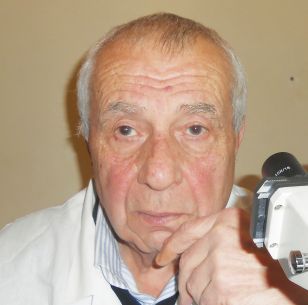
FACULTY OF MEDICINE
EXPERIMENTAL MODELING OF MANGANESE TOXIC ENCEPHALOPATHY
The project is entitled “Perspectives for using certain neuro-protectors and experimental modeling of the hormesis phenomenon of manganese toxic encephalopathy”.
In addition to organic and inorganic compounds, 20 chemical microelements are vital for the healthy life of a human being and other living organisms; one of them is bivalent manganese. Its presence in the human organism determines the functioning of a number of processes such as the intensification of enzyme-catalyzed reactions, in the organic metabolism (albuminous ferments), reproductive glands, the musculoskeletal system, nerve cell membranes and the nervous system as well as blood cleansing. The Laboratory of Experimental Neurology at I. Beritashvili Center of Experimental Biomedicine and the Department of Pathology at the TSU Faculty of Medicine began a study in January 2013, to continue until December 2016. The project is entitled “Perspectives for using certain neuro-protectors and experimental modeling of the hormesis phenomenon of manganese toxic encephalopathy”. The hormesis biological phenomenon usually relates to favorable biological responses to an exposure to toxins and other stressors. However, exposure to small amounts or toxic amounts of manganese ions can lead to negative consequences – generally, the degree of toxicity of chemical substances or ions is measured by doses, according to Body Mass Index, that can cause poisoning, or to turn into poison. The same dose of a chemical substance can affect different human organisms in different ways – indifferently, medically (as poison) and lethally. A toxic dose of poison has no lethal outcomes, while a lethal dose causes death.
 The harmful effects of manganese on the human organism were first detected in 1837, when John Couper described a syndrome similar to Parkinson’s disease in Scottish workers exposed to high levels of dust while grinding “black oxide of manganese” at a chemical plant. This “secondary parkinsonism”, or “manganism”, was an occupational disease, and can still be observed where people work in ferrous and nonferrous metallurgy and paint or glass production and petroleum. Workers are exposed to toxic doses of manganese compounds through the skin, orally or by inhalation. Since the 1990s, the intravenous use of cheap surrogate drugs and psychoactive stimulants like methcathinone (sometimes called “jeff”) containing a manganese compound has been commonly used by substance abusers and addicts in Europe, the USA and in the former Soviet republics, including Georgia. It causes grave disabilities in users, and especially manganese encephalopathy, or brain dysfunction due to toxic exposure. The problem has both medical and social dimensions.
The harmful effects of manganese on the human organism were first detected in 1837, when John Couper described a syndrome similar to Parkinson’s disease in Scottish workers exposed to high levels of dust while grinding “black oxide of manganese” at a chemical plant. This “secondary parkinsonism”, or “manganism”, was an occupational disease, and can still be observed where people work in ferrous and nonferrous metallurgy and paint or glass production and petroleum. Workers are exposed to toxic doses of manganese compounds through the skin, orally or by inhalation. Since the 1990s, the intravenous use of cheap surrogate drugs and psychoactive stimulants like methcathinone (sometimes called “jeff”) containing a manganese compound has been commonly used by substance abusers and addicts in Europe, the USA and in the former Soviet republics, including Georgia. It causes grave disabilities in users, and especially manganese encephalopathy, or brain dysfunction due to toxic exposure. The problem has both medical and social dimensions.
The key novelty of the study is to create an adequate model of valid toxic encephalopathy by injecting white rats through hypodermic intervenous intraperitoneal with potassium permanganate containing an isotonic solution (see Series in Biomedicine, 2013, v.39, #5-6,237-249). This is important for studying exposure to manganese (with a marginal value that can cause encephalopathy in experimental models). The experimental animal model created as a result of the manganese encephalopathy study is very homologous, by its physiological and behavioral indicators, to changes observed in human beings after ephedrone abuse. At the same time, chelates1 and neuroprotective drugs are used to control rigid neurological and histopathomorphological disorders typically found in manganese encephalopathy.
Against the background of modeled Mn-encephalopathy, an intramuscular injection of a chelate – calcium-monosodium-editate solution – cleans the organism of excessive manganese and controls rigid neurological disorders that form as a result of manganese intoxication. The histomorphological study revealed deep destructive changes in the cortex where there are toxic doses of manganese – multiple hematomas, thrombosis in some areas, perivascular edema, neuronal necrosis and severe transformation of internal organ tissues (liver, lungs, cardiac muscle, lymph nodes). In particular, hepatocyte dissociation and fatty dystrophy were found in the liver. In the lungs there was dilation of the alveolus, and in some places broken interalveolar septums, dilation of bronchioles and hyperplasia of the peribronchial nodes. In the myocardium disfibering occurred, and lymphoid hyperplasia was found in lymph nodes.
This study is enabling the researchers to provide an in-depth explanation for the pathogenesis of manganese toxic encephalopathy, which is of great practical importance for correct treatment. Histopathological studies of some organs in our research have shown that the changes in tissue constructs are in full correlation with neurological or pathological behavioral indicators developed in the organisms of animals or drug users (see Series in Biomedicine, 2013, v.39, #5-6, 237-249). Similar studies have great theoretical and practical importance for analyzing the etiopathogenesis of substance users, and for recommending preventive measures. Given the topicality of the issues, the study of these damaging effects is urgent, particularly because of the alarming increase in increase of synthetic drugs and production of “jeff”; of ephedrine IV users; and for occupational pathologies of workers in ferrous and nonferrous metallurgy and petrol production that cause severe human disabilities.
The study team comprises researchers from several institutes: Tamila Bagashvili, Dr of Biology, Associate Professor at the Department of Pathology of TSU Faculty of Medicine, Senior Research fellow at the Center of Experimental Biomedicine; Nikoloz Papuashvili, MD, Chief Research Fellow and Neuropathologist at the Uranti Medical Center, theme leader; Giorgi Andronikashvili, MD, Head of Laboratory; Senera Chipashvili, BioPhD, Research Fellow; Giorgi Kvernadze, BioPhD, Senior Research Fellow; Mikheil Okujava, Academic MD, Research Fellow; Tea Gurashvili, Academic MD, Research Fellow; and Ketevan Gogeshvili, Research Fellow. Researchers from the Department of Pathology include Teimuraz Jorbenadze, Academic MD, Full Professor; Giorgi Pataraia, MD, Associate Professor; and Tamila Bagashvili, D.Bio., Senior Research Fellow.
The study will be comprehensive, including clinical, experimental and histopathomorphological research using materials and technical equipment in the Laboratory of Experimental Neurology, the animal vivarium in the Center of Experimental Biomedicine, and material-technical resources in the TSU Department of Pathology.
First research results were presented at the 3rd International Symposium, Neuro-Plasticity: Neurous Substrate for Health and Disease: New Approaches for Research in Tbilisi on October 2-4, 2014, through a report “The Study of the Therapeutic Potential of Cortex in the Treatment of Methcathione (Ephedrone) – Associated Manganese Encephalopathy” by N. Papuashvili; and to the 1st International Conference in Rheology (Kutaisi, October 10-11, 2015): “As a result of the injection of manganese ions may cause histopathological changes in some visceral organs” – T. Bagashvili, N. Papuashvili, T. Jorbenadze, G. Andronikashvili, T. Gurashvili, K. Gogeshvili, pp.34-35. 2015.
(Endnotes)
1 The same as Ligand links where minerals are connected to organic molecules, including amino acids, through which microelements are transported to cell membranes to create an “internal connection” or chelate connection.





